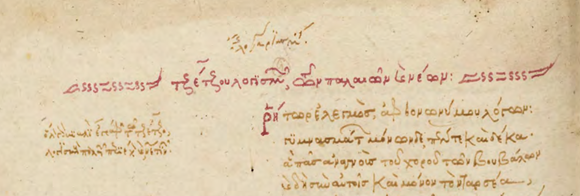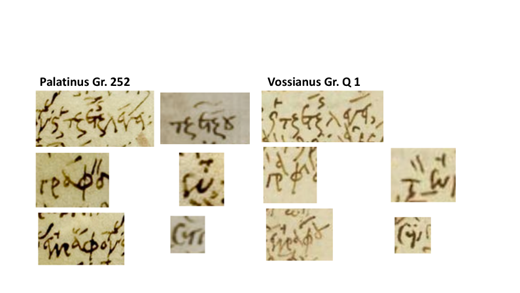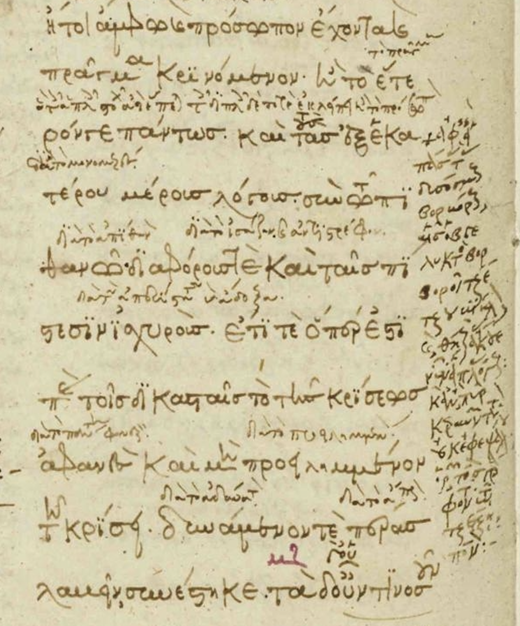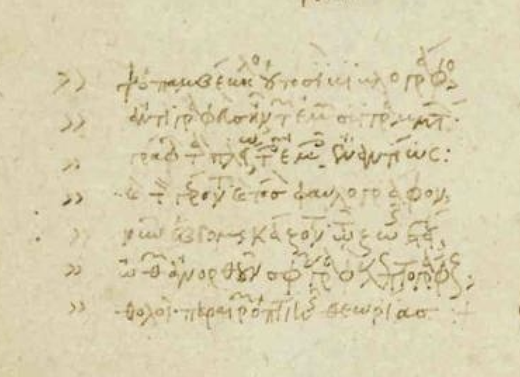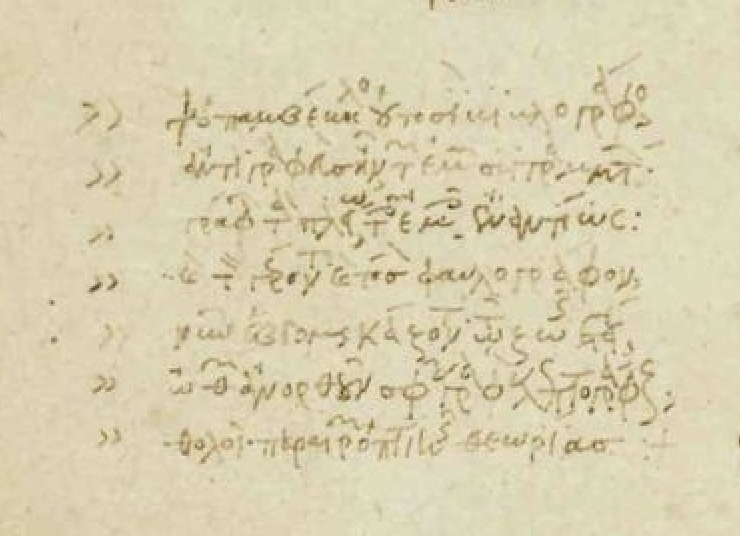
John Tzetzes in the margins of the Voss. Gr. Q1: discovering autograph notes of a Byzantine scholar
Aglae Pizzone writes about an exciting new discovery in a manuscript containing text by the Byzantine scholar John Tzetzes.
In September 2019, I was pleased to launch the project, funded by the Indipendent Research Fund Denmark, “Medieval Self-Commentaries Beyond Europe: A Transcultural Perspective” (http://cml.sdu.dk/news/cmls-aglae-pizzone-awarded-research-project-1-grant-from-independent-research-fund-denmark). Part of the project is devoted to preparing the first critical edition of John Tzetzes’ exegesis on the Hermogenian corpus. Tzetzes’ commentaries are particularly important in the cultural economy of late 12th-century Constantinople. Their author shows on several occasions that he considered his exegesis on Hermogenes crucial to his self-definition as a teacher and intellectual as well as to his self-positioning toward patrons and sponsors in the learned milieus of the capital.
A necessary preliminary step was obviously a thorough examination of the manuscript tradition. That is why, in the late summer of 2019, before the actual start of the project, I traveled to Leiden in order to examine in situ one of the most promising textual witnesses, Voss. Gr. Q1.
This manuscript, now divided into two volumes, is a silk codex of about 260 x 165 mm, including 30 quires, mostly bifolia. Quires, numbered in red ink by the main copyist, start with ε, thus showing that the codex is acephalous. The manuscript contains Aphthonios’ and Hermogenes’ texts accompanied by Tzetzes’ commentary, plus two treatises (ff. 31-36: a rhetorical epitome and a treatise on the differences and similarities between issues) that might also be by Tzetzes. The Leiden catalogue dates the Voss. Gr. Q1 to the 13th-14th century (1275-1325 in the recently updated version), but a quick examination shows that the handwriting bears striking similarities with informal scholarly hands from the late 12thcentury, with some traits that point to the Imperial chancery. Comparable examples can be found in Laur. Plut. 74.15; Vat. Gr. 1312; Ambr. C 222 inf.; Laur. Plut. 57.5. All these manuscripts have been dated back to the mid (Laur. Plut. 74.15; Vat. Gr. 1312) and second half of the 12th century (Ambr. C 222 inf.; Laur. Plut. 57.5) in the last thirty years or so.
The manuscript, moreover, proved immediately full of surprises. Not only does Voss. Gr. Q1 carry a complete version of Tzetzes’ glosses on Hermogenes, what is more, the last 28 folia contain sections devoted to Aphthonios and Hermogenes from the Logismoi, a work mentioned by Tzetzes in his oeuvre (see Scholia in Aristophanis Ranas 1328, p.1076, 43 ss. Koster; Historiae 369, XI 223-254) but hitherto believed to be lost (fig. 1). A marginal note in red ink testifies to the existence of a full book of Logismoi. Although partial, the text is packed with new valuable information on the feud between Tzetzes and the fellow literati gravitating around the imperial court and the Patriarchal School, shedding light on events alluded to in the Historiai, in Tzetzes’ self-commentary on his own letter collection, and in his Iambi.
Funnily enough, the section of the Logismoi at the end of Voss. Gr. Q1 was hidden in plain sight. Meyïer’s library catalogue (1955) pointed to the presence of the 28 folia and the title Τζέτζουλογισμῶν, τῶνπαλαιῶνκαὶνέων is recorded in the Database of Byzantine Book Epigrams as occurrence 19745 (https://www.dbbe.ugent.be/occurrences/19745). In the 19th century, moreover, a Dutch scholar interested in ancient rhetoric, John Bake, transcribed – without publishing it – most of the material by Tzetzes preserved by the manuscript, including parts of the Logismoi-sections. His notes are still to be consulted at Leiden’s University Library (BPL 1507 II) and, needless to say, are of the greatest help to today’s reader. There is enough to make any student of Byzantine literature exceedingly happy, but this is not all.
When we started transcribing the manuscript together with Elisabetta Barili, PhD candidate working with me on the project and researching the commentary on the Types of Style, we soon realized that, besides the main copyist, Voss. Gr. Q1 is dotted with marginal and interlinear notes. These glosses in dark brown ink correct mistakes, begrudgingly address the copyist and his flaws, as well as add details and supplements of information. The handwriting is utterly informal, highly idiosyncratic and shows unmistakable signs of impatience – so much so that at times the paper is punctured. From a paleographical point of view, the handwriting matches almost to perfection that of the marginal notes on the Palatine codex of Thucydides Pal. Gr. 252 (see fig. 2 for some samples). The latter were ascribed in 1999 by M.J Luzzatto to Tzetzes’ hand (Tzetzes lettore di Tucidide, Bari 1999). But it is not just paleography that points in this direction. At f. 45 v., Tzetzes names himself as the author of the glosses (fig. 3):
ἀφεὶς ἁπάσας τὰς δυσόσμους βορβόρους,
αἷς ὁ βδελυκτὸς βορβοροῖ Τζέτζου βίβλον
καὶ θηλικοὺς ἄκουε νῦν ἅπας λόγους.
Κἂν πῦρ κεραυνῶν τοῦτον οὐκ ἐφεψάλου
ὁρῶν τόσον γράφοντι τῷ Τζέτζῃ πόνον
After taking away the smelly soil,
through which the abominable man soils Tzetzes’ book
- and yes, listen everyone, it’s in the feminine,
even though you are blasting with fire, do not burn it to ashes,
seeing how much pain has been caused to Tzetzes who is writing.
At 115 v. (also f. 73), moreover, he gives precious information about himself, stating explicitly that he finds himself in the seventieth year of his life (fig. 4):
☩ παμβέβηλοςοὑτοσὶβιβλογράφος
ἀντιγραφεὺςἦντῶνἐμῶνσυγγραμάτων
γράφωντὰπλείωτοῖςἐμοῖςἐναντίως:
καὶ τὸν γέροντα καὶ τόσον φαυλογράφον
νῦν ἑβδομηκάζοντα τῷ ζωῆς ἔτει
ὠθῶν ἀνορθοῦν σφᾶς γραφὰς λεπτογράφους
θολὸν παραιρῶν ὀπτικῆς θεωρίας :☩
Thisutterlyprofanescribe
was the copyist of my treatises:
he writes most of the time contrary to my text;
and this old man, with his very bad handwriting,
now in the seventieth year of his life,
he forces him to correct his own neatly traced letters,
cleansing the visual outlook from the dirt.
These are only a couple of the most relevant clues suggesting that the glosses of the Voss. Gr. Q1 are, in fact, autograph notes by Tzetzes himself. Tzetzes most likely took the pen to edit this copy of his commentaries on the corpus Hermogenianum, which, as stated above, he viewed as particularly important within his own oeuvre. I would also like to add a personal, less scholarly, note: the language, the handwriting, the content of these glosses are so personal that, for someone who has been working on Tzetzes for quite some time now, engaging with them feels like sitting next to the author and looking at all his antics, mood swings and little quirks.
To sum up, the Voss. Gr. Q1 is a rare treasure find, one that is bound to improve immensely our understanding of 12th-century Byzantine literary production, of practices of publishing and patronage, and of the role of rhetorical theory beyond the classrooms. It shows what a powerful tool autography could become to negotiate one’s identity in the intellectual circles of a medieval metropolis. Together with Elisabetta Barili and Stefano Martinelli Tempesta (University of Milan) we plan to publish the autograph notes as soon as possible, while the Logismoi will be the object of a dedicated publication on which I am presently working. However, the Voss. Gr. Q1, in all its richness, demands an even larger shared effort. For this reason, we will in the near future join forces with Nikolaos Zagklas (University of Vienna), to make sure that its material is made available to the broader scholarly community in the best and quickest way possible.
